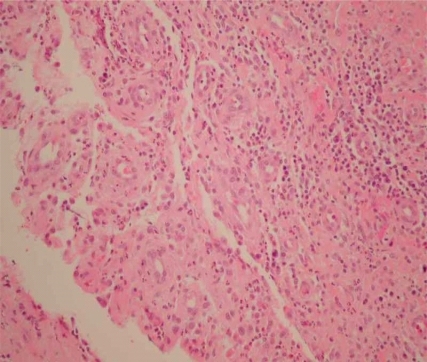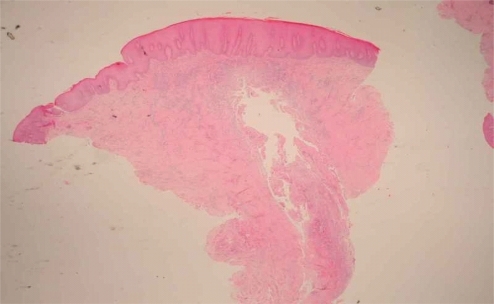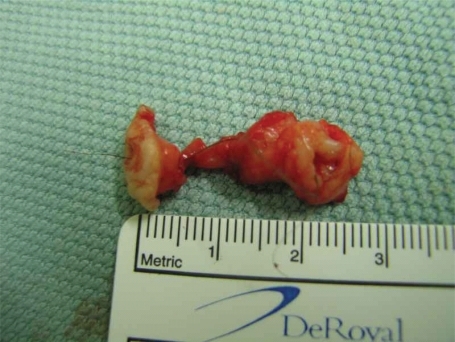Abstract
Pilonidal sinus is a well recognised chronic inflammatory condition which commonly affects the natal cleft and finger web space. Pilonidal sinus of the penis is a rare clinical entity; few cases have been reported previously. The treatment strategy is almost the same as treating any pilonidal sinus and involves total excision of the sinus. Our diagnosis was established on the histopathological findings rather than a clinical-based diagnosis, Follow-up is advisable since the recurrence rate is high. Our case report is one of few cases reported on pilonidal sinus all over the world. Our patient had total excision of the sinus with complete recovery.
Introduction
Pilonidal sinus is a well recognized chronic inflammatory condition which affects the natal cleft, finger web space, and it is rare in the penis. We report on a case of penile pilonidal sinus in a 24-year-old man who has severe mental illness, autism, and developmental delay. The literature was reviewed and there were a few cases reported worldwide (CitationVal-Bernal et al 1999; CitationChikkamuniyappa et al 2004; CitationKalsi et al 2004; CitationO’Kane et al 2004).
Case report
A 24-year-old man who is known to have severe mental illness, autism, and a learning disability, presented with more than a one year history of recurrent ulcerative lesion on the middle of the dorsum of his penile shaft, intermittent erythema, and swelling. Despite several courses of antibiotics prescribed by his local general practitioner, the lesion did not resolve and the swelling was observed to grow bigger between these episodes. Clinical examination revealed an indurated, erythematous 8–9 mm ulcerative lesion in the middle of the dorsal aspect of the penile shaft. The patient had not been circumcised and had never reported a similar complaint from anywhere else in his body. Excisional biopsy was performed, and histology showed the classical findings of pilonidal sinus with hair shaft within. It is essential to highlight the fact that diagnosis was made post-operatively based on histopathological findings rather than on preoperative clinical assessment. In some cases diagnosis can be made before operating on the patient (CitationRao et al 2006). The patient had an uneventful recovery and his symptoms have since resolved completely.
Discussion
Pilonidal sinus was first described by CitationAnderson (1847). It is a condition that affects hairy areas such as the natal cleft, axillae, perineum, finger web space in the hands of barbers, and amputation stumps (CitationSaharay et al 1997). The pathogenesis of pilonidal sinus is controversial although it is agreed that it is acquired. The present view is that the large majority of pilonidal sinuses have an acquired pathogenesis. The initiating event appears to be follicular hyperkeratosis with plugging, leading to retention of follicular products (CitationLucas 1997). The rupture of a follicular unit or a cyst with secondary infection results in abscess formation. In some instances, sinuses formed to drain the abundant suppuration. The sinuses are lined by stratified squamous epithelium and inflammatory granulation tissue. Very often, numerous hair shafts penetrate into dermis and elicit foreign body giant cell reaction (–). The inflammatory reaction subsides after the pus is discharged. In some cases the opening onto the skin is absent and there is no secondary infection. There may be a pilonidal tract or cyst in these persons. The support for the acquired theory of the pilonidal sinus comes from their occurrence in situations such as the finger web space in the hands of barbers, and in amputation stumps. Therefore many cases are acquired as a result of trauma from “jeep seat”, “rough riding syndrome”, and occupational physical injury (CitationVal-Bernal et al 1999). The literature was reviewed and a few cases were reported worldwide (CitationVal-Bernal et al 1999; CitationChikkamuniyappa et al 2004; CitationKalsi et al 2004; CitationO’Kane et al 2004). The literature referred to penile pilonidal sinus with some other pathologies such as actinomycosis infection (CitationVal-Bernal et al 1999; CitationChikkamuniyappa et al 2004) or erectile dysfunction (CitationKalsi et al 2004). Therefore, a good clinical assessment and bacteriological examination is essential to obtain better results.
In our case, we reported on a pilonidal sinus where diagnosis was made on histopathological findings with no evidence of associated bacterial infection or malignancy (CitationRao et al 2006). Our patient did not experience pilonidal sinuses problems anywhere else in his body. Our patient had full recovery and no symptoms since, his post-operative follow-up involved two out-patient visits at up to 12 weeks post-operation. The patient had no symptoms or recurrence up to that time, interval circumcision was deferred due to the patient’s general health status and his mental disability.
Disclosure
The authors report no conflicts of interest in this work.
References
- AndersonAW1847Hair extracted from an ulcerBoston Med Surg J3676
- ChikkamuniyappaSScottRSFurmanJ2004Pilonidal sinus of the glans penis associated with actinomyces case reports and review of literatureScientific World Journal49081215523564
- KalsiJSAryaMFreemanA2004A pilonidal sinus on the penis presenting with erectile dysfunctionScand J Uro Neph38923
- LucasS1997Bacterial diseaseElderDElenitsasRJaworskyCLever’s histopathology of the skinPhliadelphiaLippincott-Raven Publishers457
- O’KaneHFDugganBMulholandC2004Pilonidal sinus of penisScientific World Journal4Suppl 1258915349549
- RaoARSharmaMThyveetilM2006An unusual site for pilonidal sinusInt Urol Nephrol383–4607817111086
- SaharayMFarooquiAChappellM1997An unusual lesion of the penisPostgrad Med J731799135841
- Val-BernalJFAzcarretazabalTGarijoMF1999Pilonidal sinus of the penis. A report of two cases, one of them associated with actinomycosisJ Cutan Pathol26155810235382


